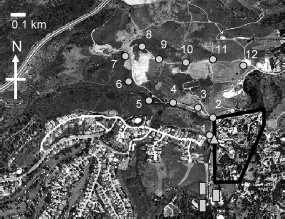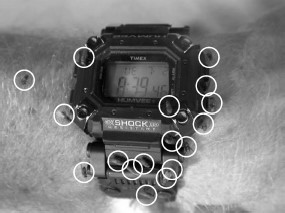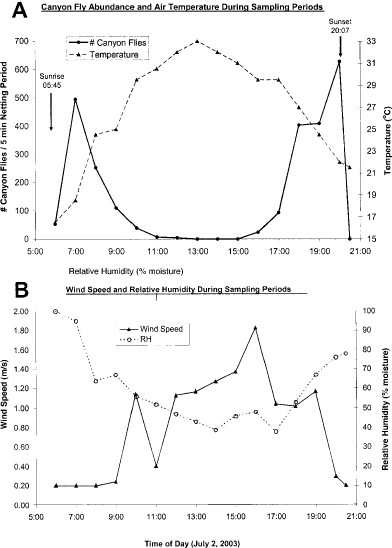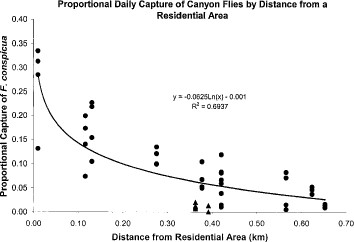-
PDF
- Split View
-
Views
-
Cite
Cite
Alec C. Gerry, Bradley A. Mullens, Adult Fannia benjamini Complex (Diptera: Muscidae) Activity in Southern California and Use of CO2 as an Attractant , Journal of Medical Entomology, Volume 43, Issue 3, 1 May 2006, Pages 467–472, https://doi.org/10.1093/jmedent/43.3.467
Close - Share Icon Share
Abstract
Diurnal activity of host-seeking "canyon flies" (Fannia benjamini complex) (Diptera: Muscidae) was determined on a warm, sunny day during their peak seasonal activity period (early July) in the coastal mountain community of La Habra Heights in Los Angeles County, California. High levels of activity persisted for several hours in the morning and evening, but peak abundance was within an hour after sunrise and an hour before sunset, when >600 flies (mainly Fannia conspicua Malloch) could be collected in 5 min from a person using a sweep net. Host-seeking activity was low during midday hours, when flies apparently were seeking shelter from the heat, and activity ceased after sunset. Potential bait materials, including some known to elicit a response by other host-seeking Diptera (water, rabbit feces, egg bait, milk bait, Limburger cheese, ethanol, and CO2) were tested for "canyon fly" response using CDC-type suction traps (without light). CO2 resulted in significantly higher capture of female "canyon flies" (up to ≈2,000 flies per trap in a 6-h period) relative to traps baited with other materials or with no bait. Host-seeking activity in relation to distance from a putative developmental site was evaluated. The proportional capture of flies in CO2-baited suction traps was significantly explained by distance from a residential area planted with Aptenia cordifolia (L.) (Aizoaceae; red apple), a ground cover plant that is a developmental site for F. conspicua. Proportional trap capture rapidly decreased as distance from the residential area increased. Implications of these studies for "canyon fly" control are discussed.
"Canyon flies" (Fannia benjamini complex) can be significant human and animal nuisance pests. Adult "canyon flies" are persistent in their attempts to land on the exposed skin of humans and are known to cluster around the eyes of deer and horses (Poorbaugh 1969). "Canyon flies" presumably feed on tears, mucus, sweat, or other human and animal body secretions, but they also feed on blood from open sores or wounds caused by biting flies (Garcia and Radovsky 1962). In the coastal mountain community of La Habra Heights (Los Angeles County, California), fly activity has caused considerable nuisance to residents and their animals since the mid-1990s (Mullens and Gerry 2006). The dominant member of the species complex in the La Habra Heights area is Fannia conspicua Malloch, which develops in decaying organic matter beneath an exotic succulent plant called red apple, Aptenia cordifolia (L.), favored as a ground cover on hillsides adjacent to homes (Mullens and Gerry 2006). F. benjamini Malloch is also present at this site but in much lower numbers. The natural developmental habitat of "canyon flies" has been speculated to include the feces of animals such as rabbits, ground squirrels, or wood rats (Chillcott 1960, Winkler and Wagner 1961, Poorbaugh 1969).
Given the considerable nuisance that these flies may cause, there is surprisingly little known about the activity of adult F. benjamini complex flies. Winkler and Wagner (1961), collected host-seeking "canyon flies" with a sweep net in the Lytle Creek area of the San Bernardino Mountains of California. They observed that on hot days, these flies were most abundant either early or late in the day and that even a slight breeze would result in cessation of host-seeking activity. Mullens and Gerry (2006) demonstrated that "canyon flies" in southern California exhibited a distinct seasonality, with peak abundance occurring in spring and early summer, followed by a rapid drop in abundance with the onset of hotter weather.
The purpose of the current study was to evaluate F. benjamini complex diel and spatial activity during a period of peak abundance and to determine the value of bait materials for use with CDC-type suction traps for collection of adult "canyon flies".
Materials and Methods
Adult Diel Activity.
On 2 July 2003, host-seeking "canyon flies" were collected from 0600 (15 min after sunrise) until 2030 (23 min after sunset) hours at a location in the city of La Habra Heights, Los Angeles County (33° 57′ N, 117° 57′ W, 280-m elevation) known to have a considerable number of F. benjamini complex flies (Fig. 1). This area has been described in Mullens and Gerry (2006). Sampling was conducted on a warm, sunny day typical for this location during June and July when fly host-seeking activity is at its peak (Mullens and Gerry 2006). Collections of host-seeking "canyon flies" were made for 5 min at the start of each hour, beginning at 0600 hours, by using a short-handled sweep net to capture flies attracted to the vicinity of the researcher. A final 5-min sampling was conducted at 2030 hours to determine whether host-seeking persisted after sunset. Flies captured during each 5-min sampling period were killed in a cooler with dry ice, placed into a labeled glass vial, and returned to the laboratory to be identified (Turner 1976) and counted. Temperature, relative humidity, and wind speed were recorded immediately before the start of each 5-min sampling period to determine the effect of these environmental conditions on host-seeking activity.

Aerial view of the study site in the city of La Habra Heights, CA. Location of the diel host-seeking activity study is indicated by . Trap lines used for the bait attraction study are indicated by . Trap sites 1–12 used to determine F. benjamini complex fly activity relative to distance from a residential area with canyon fly developmental sites are indicated by . The residential area encompassed within the black border has several homes (most notably, one adjacent to trap site 2) landscaped with red apple that is mature enough to serve as a developmental site for F. conspicua.
The number of flies captured during each collection period was transformed using log10 (n + 1) before statistical analysis. The relationship of temperature, relative humidity, and wind speed to host-seeking activity was analyzed by Pearson correlation.
Evaluation of Potential Attractants.
CDC-type miniature suction traps (John W. Hock, Gainesville, FL), with the light removed, were placed into three trap lines of four traps each in the vicinity of an equestrian ring located near the site described above (Fig. 1). These trap lines were placed ≈500 m away from the site used to determine diel activity of adult flies. Trap lines were deployed perpendicular to prevailing westerly breezes, with a minimum 50 m between trap lines. The four traps within a trap line were separated from one another by a distance of 5 m. Traps were suspended 0.7 m above ground and 10 cm below a brown 3.8-liter insulated paint can with a lid. The paint can was lined with foam and had four holes (1.3 cm in diameter), one on each side of the can and two on the bottom. Traps were baited with one of the following: no bait, 1 kg of dry ice (CO2), 100 g of Limburger cheese, 50 ml of fermented eggs (raw chicken eggs and water [1:10], fermented for 48–72 h), 50 g of domestic rabbit pellets (feces) moistened with 10 ml of deionized water, 100 ml of 70% ethanol (EtOH) absorbed into a small block of florist foam, or two paper towels soaked with 50 ml of either water or fermented milk (5 g of powdered milk, 20 g of granulated sugar, and 1.5 g of active dry yeast placed into 300 ml of water and fermented for 24 h). Dry ice (CO2) was placed in the insulated paint can, and the sublimated gas flowed out through the four holes. All other bait materials were placed into a 225-ml wax-coated paper cup that was suspended between the paint can and the suction trap.
Trapping was conducted on 4 d between mid-June and mid-July 2003 during a period of high "canyon fly" abundance. For three of the four trapping days, the sampling period ranged from 2 to 4 h and began between 0900 and 1000 hours. On the remaining trapping day (2 July 2003), sampling began at 0645 hours and continued to 1230 hours to take advantage of greater "canyon fly" activity during the early morning hours. Four bait materials were tested on each trapping day with each bait material randomly assigned to a trap location within each trap line. Two of the bait materials (nothing and CO2) were tested on all four trapping days and served as a negative and positive control, respectively. Two of the bait materials (rabbit feces and fermented eggs) were tested on two of the trapping days, whereas all other bait materials (water, 70% EtOH, Limburger cheese, and fermented milk) were tested on a single trapping day. Flies captured in each trap during the sampling period were killed in a cooler with dry ice, placed into separate labeled glass vials, and returned to the laboratory to be identified and counted.
The number of flies captured in each trap was transformed using log10 (n + 1) before analysis by the GLM procedure for differences among bait treatments for each trap day. Treatment means were separated by Tukey’s honestly significant difference (HSD) test.
Activity in Relation to Distance from Developmental Site.
CDC-type suction traps with the light removed were baited with 1 kg of dry ice each and placed at 12 locations at 0.16-km intervals along a dirt road extending from a residential area with abundant host-seeking "canyon flies" into an adjacent native habitat preserve (Fig. 1). The dirt road extended into the native habitat preserve for 0.65 km (trap sites 1–7) before turning back somewhat toward the residential area (trap sites 8–12). A residential home adjacent to trap site 2 had abundant red apple ground cover that was at least a few years old and would be expected to serve as a development site for F. conspicua (Mullens and Gerry 2006). Trapping was conducted from 0930 to 1300 hours on 4 d in late June and early July 2004. Captured flies were killed in a cooler with dry ice, placed into separate labeled glass vials, and returned to the laboratory to be identified and counted.
The number of "canyon flies" captured in each trap was converted into a proportion of the total flies captured for each day. Regression analysis was performed on proportional data to determine the extent to which distance from the residential area would predict proportional fly capture.
Results and Discussion
Adult Diel Activity.
Adult flies could be collected from dawn to dusk, with high levels of activity (>100 flies per 5-min sweep netting period) for several hours in the morning and evening (Fig. 2). Persistent attraction to the collectors was interpreted as host seeking. Host-seeking "canyon flies" demonstrated a distinct diel pattern, with peak host-seeking activity concentrated in the hour after sunrise and before sunset, with 495 and 628 flies captured, respectively, during a 5-min netting period (Fig. 3A). F. benjamini comprised only 2.7% of a subsample of 565 flies captured on this date with the remainder of the flies being F. conspicua. A substantial reduction in host-seeking activity occurred during the middle of the day with essentially no host-seeking occurring during the hottest hours of the day (1300–1500). Although host-seeking activity during the morning hours seemed to cease when wind speeds began to increase as was suggested by Winkler and Wagner (1961), host-seeking activity in late afternoon increased even in the presence of moderate winds (Fig. 3B). Host-seeking activity was inversely related to temperature (r = -0.53, df = 14, P < 0.05) but was not significantly related to either wind speed (r = -0.33, df = 14, P = 0.2) or relative humidity (r = 0.46, df = 14, P = 0.08). Host seeking by "canyon flies" ceased abruptly after sunset, even though there was still sufficient light to collect flies, indicating that host-seeking activity was strictly diurnal.

Host-seeking F. benjamini complex. Flies seem to be attracted to sweat and will commonly land on or near the feet and waist as well as items such as wrist watches where sweat odors might build up. Note the 17 flies in this image (circled), which overall seem to have a preference for areas of the watch that are in direct contact with the skin.

Abundance of host-seeking F. benjamini complex flies and environmental conditions measured during 5-min sampling periods on a single day during the seasonal peak in abundance.
Although diel activity was determined on a single day, environmental conditions on this day were typical for June and July when adult "canyon fly" host-seeking activity is at its peak (Mullens and Gerry 2006). On hot days, venturing into shaded (dense vegetation) areas during mid-day hours resulted in the immediate resumption of host-seeking activity by "canyon flies" that were presumably sheltering there. Furthermore, it was noted that on cooler and overcast days, "canyon fly" host-seeking activity continued throughout the midday hours, although at reduced levels. Similarly, it would be expected that host-seeking activity during midday hours would increase relative to early morning and late afternoon activity during cooler months in comparison with the peak activity period in June and July.
Evaluation of Potential Baits.
Suction traps baited with CO2 (dry ice) caught much greater numbers of "canyon flies" (73–99% of the total flies captured, depending on the test day) relative to all other baits tested (Table 1). Traps baited with CO2 captured significantly more flies than traps baited with any other material on trap days 1–3 (F > 9.64; df = 3, 8; P < 0.007) and significantly more flies than traps baited with any material except fermented eggs on trap day 4 (F = 11.16, df = 3, 7; P < 0.005). Traps baited with materials other than CO2 or fermented eggs were not significantly different from the nonbaited control traps for all trapping days.
Mean trap catch ±SD of adult female F. conspicua by bait treatment for each trapping day

Mean trap catch ±SD of adult female F. conspicua by bait treatment for each trapping day

All "canyon flies" captured in baited suction traps were female regardless of the bait used. On 2 July when the sampling period began just after sunrise and continued for nearly 6 h, a single CO2-baited suction trap captured 3,073 "canyon flies", with nearly 6,000 flies captured by all three CO2-baited traps. The majority of "canyon flies" captured during these studies was F. conspicua—only 14 of the 7,112 "canyon flies" captured (0.2%) were F. benjamini, all of which were captured in suction traps baited with CO2.
Carbon dioxide is regarded as a potent and essentially universal kairomone for blood-feeding Diptera (Gibson and Torr 1999). However, its activity for flies that frequent animals or people, but presumably cannot create a bleeding wound, is less well known. The face fly, Musca autumnalis De Geer, requires host-derived proteins (e.g., in tears) for egg development, and on-host (cattle) populations tend to be heavily female-biased (Pickens and Miller 1980). There is at least anecdotal evidence that face flies respond to carbon dioxide-baited traps in the field (Pickens and Miller 1980). The powerful attraction of "canyon flies" to carbon dioxide indicates vertebrate hosts have something they require (perhaps protein-rich secretions useful for egg development).
A bait of fermented chicken eggs is used by some local vector control districts for control of eye gnats (Hippelates spp.) (Mulla et al. 1990), and "canyon fly" response to fermented eggs merits further investigation. Although the response was not as substantial as that to carbon dioxide, the bait may offer clues to adult "canyon fly" feeding requirements or chemicals useful in future monitoring or trapping programs.
Other materials were not obviously active for "canyon flies" in the field tests. Water, rabbit feces, fermented milk, ethanol, and Limburger cheese were not different from the negative control. Rabbit feces were tested based on the speculation that this was a natural development site for "canyon fly" (Poorbaugh 1969) and might be attractive for gravid females. Fermented milk and ethanol were tested based on the known attraction of other pest flies to products of fermentation (Brown et al. 1961, Mulla et al. 1977, Hwang et al. 1978, Chapman et al. 1998). Limburger cheese was tested based on the observed activity of "canyon flies" around human feet, and its activity for Anopheles gambiae Giles, which also is attracted to Limburger and certain chemicals associated with human feet (Knols et al. 1997).
Activity in Relation to Distance from Developmental Site.
Proportional daily trap capture was significantly explained by the distance of each trap site from the residential area (F = 66.93; df = 1, 46; P < 0.000), with trap sites closest to the residential area having the greatest proportional fly captures (Fig. 4). A logarithmic regression line provided the best fit of the data (R2 = 0.69). Two of the trap sites (sites 11 and 12, indicated in Fig. 4 as ▴>) had lower capture rates than would be expected given their distance from the residential area; however, this low capture may have been because of their placement in areas almost entirely lacking nearby vegetation and subject to stronger winds (an open ridge and an open hilltop, respectively). Removing trap sites 11 and 12 from analysis increased the regression coefficient (R2 = 0.73). The highest single trap capture was 227 flies captured at trap site 1 on 22 June. Total flies captured per day were 1,310 for 22 June, and 485, 442, and 298 for 2, 8, and 15 July, respectively. All flies captured were female. Whereas few F. benjamini were collected during this study, the eight individual females collected were all captured at trap sites 1–5 nearest to the residential area.

Proportional daily capture of F. conspicua by distance of trap site away from a residential area landscaped with an exotic succulent plant on which larvae will develop (see Fig. 1). Traps were placed along a dirt road extending from the residential area into an adjacent native habitat preserve. Trap sites indicated with a ▲ (sites 11 and 12) were located in areas lacking vegetation and subject to greater wind disturbance that may have affected trap capture.
"Canyon flies" may concentrate at residential homes for several reasons, including escape from adverse environmental conditions (it may be hotter or drier in the adjacent nature preserve) or presence of appropriate food sources. However, it is likely that the gradient in fly capture reflects the development of F. conspicua on red apple ground cover widely planted in the residential area near trap site 2 and the subsequent dispersal of adult flies into the surrounding natural area.
On three of the four trapping days (2, 8, and 15 July), the number of "canyon flies" captured was reduced by 53–70% at a distance of only 0.28 km from the residential area and by 75–98% at a distance of 0.57 km from the residential area. However, on the first trapping day (22 June), the number of "canyon flies" captured in traps was reduced by only 8% at a distance of 0.28 km from the residential area and by only 48% at 0.57 km. Cloud cover present on 22 June may have resulted in greater dispersal of flies from the residential area or greater survival of flies that had dispersed into the relatively dry native habitat adjacent to the residential area.
Implications for Control.
Large numbers of F. benjamini complex flies were collected in a short period (≈6,000 flies in 18 trap-hours) during the peak F. conspicua abundance period in early July. A control program using CO2-baited suction traps to remove host-seeking flies (a trap out program) merits investigation. Such a control program could be feasible given the limited peak seasonality (early June to mid-July) of these flies and their restricted diel activity on typical early summer days. Traps baited with fermented eggs, although not as effective as CO2-baited traps, were somewhat effective at capturing flies relative to nonbaited traps and may have potential as a low cost alternative to the more expensive CO2-baited traps. A consumable, attractive food source (perhaps related to fermented eggs) might have use in conjunction with a toxicant, as has been used rather successfully against Hippelates spp. in southern California desert regions (Mulla et al. 1990). Also, traps with fermented eggs (or other consumable attractant) could remain in place over many days before bait replacement would be needed. The effectiveness of such trap out programs would depend, in part, on the ability of these baited traps to remove a large part of the population of host-seeking flies. Estimation of actual size of the host-seeking population of flies was not attempted in these studies, nor was an attempt made to compare the attraction of host-seeking flies to human and/or animal hosts relative to baited traps.
Removal of red apple ground cover from an area of concern may provide relief from the activity of these flies. Host-seeking activity is greatly reduced at even relatively short distances from a developmental site, except perhaps on cool or cloudy summer days. Although the native developmental habitat for "canyon flies" in southern California remains unknown, reduced captures of "canyon flies" at traps located within an area of native habitat indicates that "canyon fly" development in this southern California coastal mountain community in the absence of red apple would likely be limited. To better evaluate this possible control option, additional research is needed to determine "canyon fly" dispersal and their expected mortality rate during the peak activity season.
Alternative options for control beyond removal of the red apple ground cover or implementation of a trapping program may include the use of insect repellents. Although the effectiveness of repellents was not evaluated in these studies, the limited diel activity as well as the limited seasonality of these flies would require the use of effective repellents only during the few times when one might expect to come into contact with host-seeking flies outside the home. Animals housed outside the home could be protected using more persistent repellent compounds applied to the animals throughout the short season of peak F. benjamini complex activity.
Acknowledgements
We thank the city of La Habra Heights for funding these studies and the Puente Hills Landfill Native Habitat Authority for providing access to the Native Habitat Preserve. We also thank Tamim Nawaey and Coralie Szijj for assistance in sorting and identifying collected specimens.
References Cited



